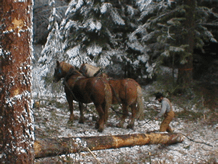China’s effect on the U.S. timber industry is a classic story of supply and demand, with winners and losers.
U.S. home building continues to lag far below pre-recession levels. Meanwhile, millions of new homes are being built in rapidly growing China, the largest foreign customer for Oregon timber.
Demand by China has driven up timber harvests and log prices, even though the domestic market for wood products is weak.
Since most of the timber bound for overseas leaves Oregon in the form of raw logs, rather than finished wood products, China has kept loggers working and benefited timberland owners. But it’s put the squeeze on mills.
“It’s a mixed blessing. It’s had a negative effect on our milling infrastructure, but it’s a positive for our loggers and landowners,” said Bob Ragon, executive director of Roseburg-based Douglas Timber Operators, a timber advocacy group.
Until a few weeks ago, ports almost couldn’t load ships fast enough to sate China’s appetite for logs. In the first half of this year, the West Coast exported nearly 1 billion board feet of logs, mostly to China. That was a 79 percent increase over the same period in 2010, U.S. Forest Service economists found.
Oregon supplied more than half the logs, a total of 518.5 million board feet. Industry veterans say the developing Chinese market brought on record log prices, sometimes almost double normal prices.
Today, exports to China are in a lull. But industry insiders expect the hiatus to be only temporary and for demand to rise again in the spring.
“I guess that’s what happens when you do business with China. In the past, China has been known to do this, jump in and jump out,” Ragon said.
The hot-and-cold Chinese market adds a new element of uncertainty to the ailing wood products industry, which can’t afford to compete with China for logs when plywood and two-by-fours aren’t selling at home.
The volatile Chinese market has left people questioning whether China will become a dependable customer as lawmakers court the Chinese to buy American.
State Rep. Tim Freeman, R-Roseburg, went to China with a delegation of Oregon lawmakers in September and said China’s “emerging economy and boom has created a situation where they’re consuming more than they can produce.”
He said Oregon’s annual exports to China total $4 billion, quadruple exports eight years ago, and are mostly made up of commodities from Intel and other high-tech companies.
Freeman said Oregon’s proximity to the Pacific Rim should make China a growing market. Freeman said the delegation didn’t discuss log exports with their hosts.
Ragon and others say the best-case scenario would be for the Chinese to buy finished wood products from Oregon mills.
Ragon said exporting manufactured wood products, instead of logs, would triple or quadruple employment throughout the industry.
For now though, far more of Oregon’s cut trees are exported as logs rather than finished products, by a ratio of 10 to 1.
Oregon Employment Department Regional Economist Brian Rooney reports that mill jobs outnumber logging jobs by three to one in Douglas County. The number mill jobs, however, is declining. Rooney said the booming export market drove a slight increase in logging jobs, but not enough to offset the loss of mill jobs.
Oregon State University Extension Service forestry agent Steve Bowers said high log prices particularly benefited landowners with stands of Sitka spruce, hemlock and white fir — trees not as coveted by mills as Douglas fir.
Bowers said China, which has different building needs, was indiscriminate in the wood it bought. China’s demand for all types of logs, however, naturally drove up the price for Douglas fir, too.
“Export was dictating the values for domestic buyers, and they did not like that,” he said.
The president and CEO of Lone Rock Timber Co., Toby Luther, said the Roseburg logging company sends less than 10 percent of its logs to exporters. But the statewide increase in logging was driven by China.
“The amount of harvest is up, and that’s not because of mills. It’s because of China,” Luther said. “My concern is that, China continues to buy up logs and makes mills less competitive in terms of accessing logs at a price they can afford.”
Luther said log prices are comparable to what they were during the building boom in 2004-05, but mills can’t justify paying those high prices because of low domestic sales.
When Glendale-based Swanson Group this month announced temporary shutdowns, beginning Monday, that will affect all four of its mills and 700 employees, company President Steve Swanson blamed the foreign competition for logs.
Jim Dudley, log procurement and marketing manager for Roseburg Forest Products, said RFP has experienced similar price pressure. Most West Coast manufacturers are suffering losses, he said.
Nevertheless, there is an upside for manufacturers. Dudley said the export market has sustained logging companies that wood products manufacturers will need when home building bounces back in the U.S.
“While (foreign competition) has been difficult to compete with on the manufacturing side, it has helped us protect our logging infrastructure. If we get any increase in domestic demand, it’s important to have that infrastructure,” he said.
Dudley and others in the logging industry say more federal logs, which can’t be exported, would ease the large price swings the Chinese market has caused.
Dudley said if logging on federal lands were increased to even one-fourth of what it was 20 years ago, before the spotted owl was listed as a threatened species, mills would have a steady supply of timber.
The ailing industry is almost entirely dependent on logging from private lands, he said.
According to the Oregon Department of Forestry, 75 percent of the state’s timber harvest occurs on private land, which makes up 38 percent of the state’s forests. Federal forests make up 59 percent of the resource and contribute 12 percent of the state’s timber production.
In Douglas County, private lands account for 44 percent of forestland and supplied 86 percent of the harvest in 2010. A majority of the county’s timberland, 54 percent, are on federal lands and produced 12 percent of the harvest.
“Now the onus has been put on private property to provide all the jobs for the Oregon forest industry,” Dudley said.
Environmentalists counter that the onus for providing wildlife habitat falls on federal lands.
“It seems to me that if the industry wants public logs, they have some responsibility to provide some habitat on their lands,” said Ken Carloni, president of Umpqua Watersheds, a Roseburg-based conservation group.
Carloni said only a lack of “cheap federal logs” was cramping domestic supply and suggested an export tax on raw logs could encourage China to purchase processed lumber instead.
“If it weren’t so attractive to ship the logs, then the domestic supply of logs would increase. Just as much fiber should be hitting those freighters and going overseas, it just should be square instead of round,” he said.
Industry leaders say unless there was a global agreement such a tax would drive the Chinese to buy logs from other countries, like Canada and Argentina.
“You put protectionist taxes on timber and you could tax your way right out of the market,” said Dave Stroble, Southwest Washington and Oregon region manager for Merrill & Ring, a Seattle-based log exporter.
Stroble said U.S. log exporters are in a wait-and-see period as the competitive Chinese market develops.
“The longer it lasts, the more it will mature. It could take years or decades to reach a level of stabilization that we’re used to over here, and it’s hard to speculate how this market is going to mature,” he said.









